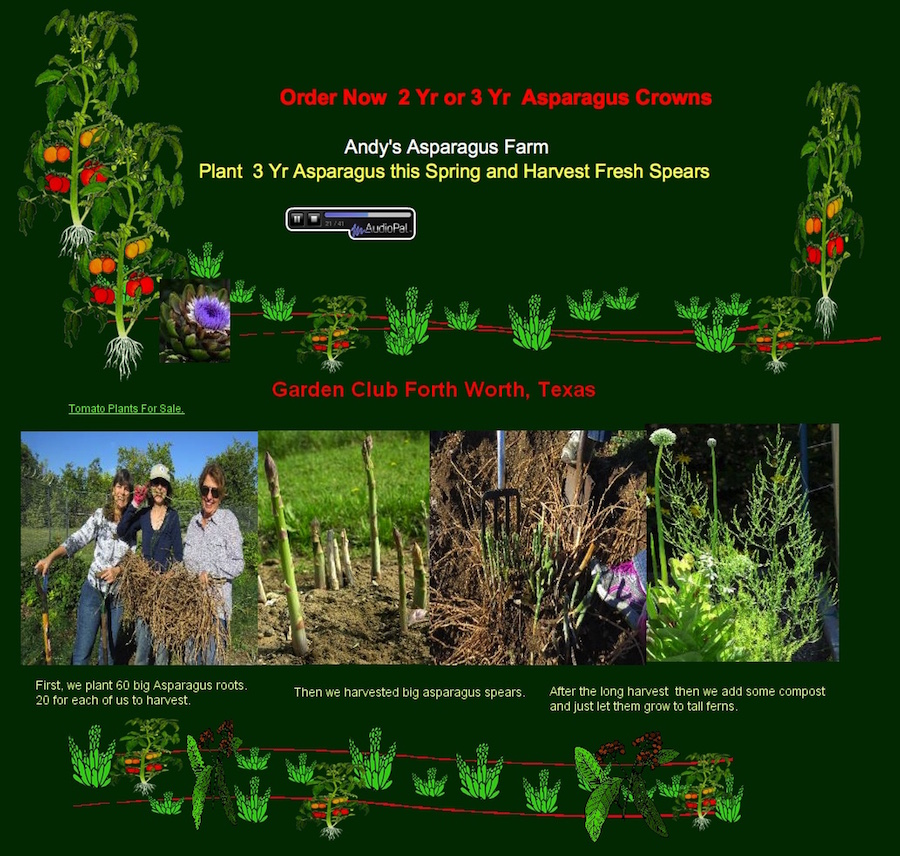About Asparagus
Asparagus has been used as a vegetable and medicine, owing to its delicate flavour, diuretic properties, and more. It is pictured as an offering on an Egyptian frieze dating to 3000 BC. In ancient times, it was also known in Syria and in Spain.
Greeks and Romans ate it fresh when in season, and dried the vegetable for use in winter; Roman Epicureans even froze it high in the Alps, for the Feast of Epicurus. Emperor Augustus created the "Asparagus Fleet" for hauling the vegetable, and coined the expression "faster than cooking asparagus" for quick action.
Unlike most vegetables, asparagus plants are perennial, which means the same plants grow in your garden year after year. The spears that we enjoy as a vegetable are the new shoots that emerge in spring.
The most important part of growing asparagus is to realize that it will take a couple of seasons before you taste the first bite of homegrown asparagus. Plants need to be allowed to mature before you can harvest. They will recontent in the same place in your garden for many years—15, 20, sometimes 30.
We Love Asparagus But They Did Not Love Us
Several years, we dudifully went down and bought/planted asparagus... Nil, Nada.. Then we went and read on the internet that they do NOT produce for at least three years. We were NOT goig to wait so we did a search and found a place in Tennessee that sells three year old asparagus crowns. The products are excellent... Everyone of the 24 we bought came up just fine! Try andyasparagus.com

Sex First!
The plants with berries are female plants, and the ones without berries are male plants. If you grow asparagus to eat, you generally want to cultivate only the males, as they don't waste energy producing seeds (berries). This lets the male plants grow larger and tastier.
Both male and female asparagus plants produce flowers. The plants rely on insects to carry pollen from the male flowers to the female flowers. If successfully pollinated, the female flowers will develop into berries, which eventually ripen, fall to the ground, and sprout. If they do not pollinate, they still product asparagus but no berries.
Boys Yeah!
Asparagus plants are either males or female. The female plant will develop many spears, but when harvesting asparagus one will have the most productive harvest from male plants. Learning how to harvest asparagus includes knowing the difference between the male and female plants, which is easily discovered once the delicious vegetable appears and grows.
Female plants devote much of their energy to seed production and can be identified when red berry-like seeds appear later in the season. Male plants, who devote no energy to seed production, offer thicker and longer spears which are what one desires when harvesting asparagus. Newer varieties of asparagus are available that offer only male plants not needing pollination.
Fertilizing Asparagus
It's generally a good idea to think about fertilizing asparagus in the hot summer months of July or August. If you planted asparagus earlier in the year, the shoots are elongated and becoming woody. The ferns may have even begun to emerge from the shoots. If you have a well-established asparagus patch, the ferns are probably growing like crazy. Now is the time for fertilizing asparagus.
Choose a good fertilizer with higher phosphate and potassium levels. A 5-10-10 or 8-24-24 fertilizer formula will work well. Pay attention to the 3 number code on the bag of fertilizer. These three numbers indicate the amount of nitrogen, phosphate and potassium that are contained in that particular fertilizer, respectively. For instance, a 10-10-10 fertilizer contains 10% nitrogen, 10% phosphate and 10% potassium. A 5-10-10 bag would contain 5% nitrogen, 10% phosphate and 10% potassium.
Growing Asparagus Spear
Use you hands and sprinkle the fertilizer granules on the ground around the asparagus plants, making sure that the granules do NOT come in contact with the plants themselves. This may burn the plants or have other negative consequences. Follow the manufacturer's directions for the amount of fertilizer to apply. Most are applied at a rate of 1 1/2 pounds per 100 square feet. After applying the fertilizer, water it in well. This will allow the nutrients to enter the soil and be absorbed by the root system.
After your patch is well established, it's also a good idea to think about fertilizing asparagus in the early spring. Again, use a phosphate and potassium rich fertilizer. This will give your plants the boost they need to produce lots of high quality spears that can be harvested later.
Asparagus plants are generally fairly drought resistant by nature because they have deep root systems. However, some research suggests that yields may be significantly higher if the soil moisture is steadily contenttained. Use your hand or a small trowel to dig down 6-8 inches into the soil. If the dirt appears to be dry, a long soak is probably a good idea. When watering asparagus, concentrate your efforts at the base of the plants. If you avoid watering the tops of the plants, they will be less likely to develop fungus-related diseases. It's also a good idea to water in the early morning hours. This will allow the afternoon sun to evaporate any moisture that may be clinging to the tops of the plants. In drought conditions, you should water the asparagus plants thoroughly every 10-14 days.
2016 Was Our Year For Asparagus

The asparagus was hidden behind the tomato plants but still produced in three years!